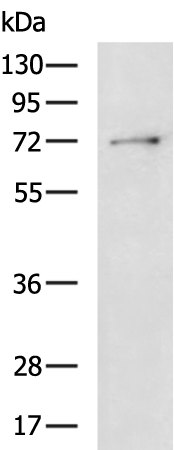
| WB | 咨询技术 | Human,Mouse,Rat |
| IF | 咨询技术 | Human,Mouse,Rat |
| IHC | 咨询技术 | Human,Mouse,Rat |
| ICC | 技术咨询 | Human,Mouse,Rat |
| FCM | 咨询技术 | Human,Mouse,Rat |
| Elisa | 1/5000-1/10000 | Human,Mouse,Rat |
| Aliases | GOA; RNF100 |
| WB Predicted band size | 70 kDa |
| Host/Isotype | Rabbit IgG |
| Antibody Type | Primary antibody |
| Storage | Store at 4°C short term. Aliquot and store at -20°C long term. Avoid freeze/thaw cycles. |
| Species Reactivity | Human, Mouse |
| Immunogen | Synthetic peptide of human TRIM47 |
| Formulation | Purified antibody in PBS with 0.05% sodium azide and 50% glycerol. |
+ +
以下是关于TRIM47抗体的3篇参考文献及其摘要概括:
1. **"TRIM47 promotes gastric cancer progression by activating the AKT/mTOR pathway"**
- **作者**: Wang Y, Chen J, et al.
- **摘要**: 研究揭示了TRIM47在胃癌中通过增强AKT/mTOR信号通路促进肿瘤细胞增殖和侵袭,抗体的应用证实了其高表达与患者不良预后相关。
2. **"TRIM47 stabilizes EGFR and drives tumorigenicity in non-small cell lung cancer"**
- **作者**: Zhang L, Liu X, et al.
- **摘要**: 利用TRIM47抗体,研究发现其通过抑制EGFR泛素化降解,稳定EGFR蛋白水平,从而促进肺癌细胞生长和耐药性。
3. **"TRIM47 as a novel prognostic biomarker in colorectal cancer via Wnt/β-catenin signaling"**
- **作者**: Xie H, Li S, et al.
- **摘要**: 通过免疫组化(TRIM47抗体)和分子实验,证明TRIM47通过激活Wnt/β-catenin通路加速结直肠癌转移,并与临床分期正相关。
以上研究均通过TRIM47抗体验证了其在肿瘤中的功能及机制,可作为疾病治疗或诊断的潜在靶点。
The TRIM47 antibody targets the TRIM47 protein, a member of the tripartite motif (TRIM) family characterized by conserved RING, B-box, and coiled-coil domains. TRIM proteins are implicated in diverse cellular processes, including ubiquitination, transcriptional regulation, and immune responses. TRIM47. encoded on chromosome 17q25.3. has gained attention for its oncogenic roles in various cancers. Studies suggest it is overexpressed in malignancies such as glioma, lung adenocarcinoma, and colorectal cancer, where it promotes tumor progression by enhancing cell proliferation, migration, and invasion. Its mechanisms may involve interactions with signaling pathways like NF-κB or Wnt/β-catenin.
TRIM47 antibodies are essential tools for detecting protein expression in research applications like Western blotting, immunohistochemistry (IHC), and immunofluorescence (IF). These antibodies help elucidate TRIM47’s tissue-specific distribution, subcellular localization (commonly cytoplasmic), and association with clinical outcomes. Recent investigations also explore its potential as a diagnostic or prognostic biomarker. However, TRIM47’s physiological functions remain partially understood, with some studies hinting at roles in innate immunity or viral defense. Commercial TRIM47 antibodies vary in specificity, necessitating validation via knockdown/knockout controls to ensure reliability in experimental settings.
×